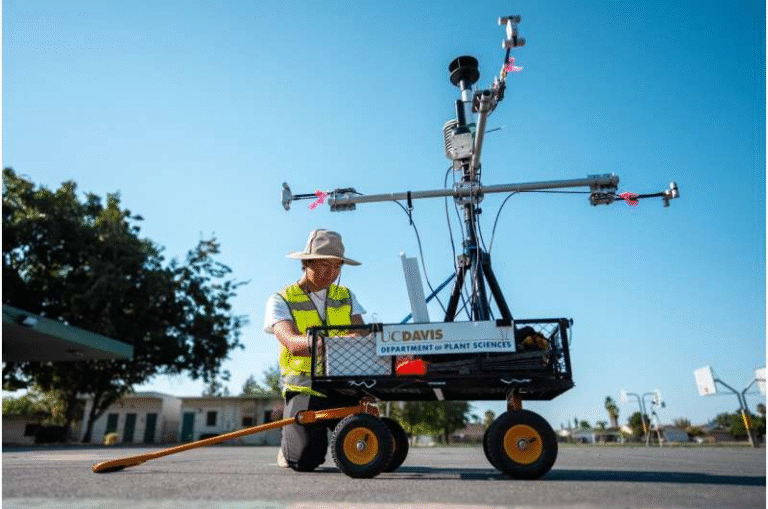A Mysterious Ozone Surge Found in Mars’s Frozen Polar Night

Scientists have uncovered an intriguing phenomenon high above Mars’s north pole — a massive buildup of ozone inside the planet’s winter polar vortex. This discovery offers a rare glimpse into how the Red Planet’s atmosphere behaves during its darkest, coldest months and provides clues about Mars’s chemical past — and perhaps its habitability.
Researchers studying data from ESA’s ExoMars Trace Gas Orbiter (TGO) and NASA’s Mars Reconnaissance Orbiter (MRO) found that the air trapped inside the north polar vortex during winter becomes about 40 degrees Celsius colder than the surrounding atmosphere. These extreme conditions cause nearly all the available water vapor in the air to freeze and settle onto the polar ice cap, setting off a chain reaction in the planet’s atmospheric chemistry.
When water vapor disappears from the air, the usual process that destroys ozone stops working. As a result, ozone levels soar inside the vortex, forming what scientists call a “seasonal ozone layer” — a temporary feature that only appears in the cold, sunless depths of the Martian winter.
This finding was presented by Dr. Kevin Olsen from the University of Oxford at the EPSC-DPS2025 Joint Meeting in Helsinki, where planetary scientists gathered to discuss new discoveries about Mars.
What Is the Polar Vortex on Mars?
Mars, like Earth, has an axis that’s tilted — about 25.2 degrees — which gives it distinct seasons. As Martian summer ends in the north, sunlight fades and temperatures drop, causing an enormous whirlpool of cold air to form above the pole. This is the Martian polar vortex.
The vortex can persist for months, spanning altitudes from the surface up to 30 kilometers. Within it, air becomes isolated from the rest of the planet’s atmosphere, trapping gases and chemicals inside. On Earth, polar vortices also occur, and when they destabilize, they can send icy air spilling toward lower latitudes — the same kind of event that causes “polar vortex” cold snaps in North America.
Mars’s vortex behaves in a similar way. It sometimes loses its perfect circular shape and drifts southward, giving orbiting spacecraft a rare chance to peek inside its dark and frigid interior.
A Peek Inside Mars’s Frozen Vortex
Studying the Martian polar vortex has always been difficult. During winter, the north pole is plunged into total darkness, making it nearly impossible for sunlight-based instruments to work.
To overcome this, Dr. Olsen and his team used a clever combination of data sources. The Atmospheric Chemistry Suite (ACS) aboard ESA’s ExoMars Trace Gas Orbiter can identify gases by observing how sunlight filters through the atmosphere at the planet’s edge. But since there’s no sunlight during polar night, the team needed another way to know where the vortex was and when it might distort enough to reveal its interior.
That’s where NASA’s Mars Climate Sounder (MCS) came in. The MCS instrument measures temperature profiles across Mars, allowing researchers to locate the vortex boundaries by spotting sudden drops in temperature — the unmistakable signature of entering its cold interior. By combining the two datasets — ozone measurements from ACS and temperature readings from MCS — scientists could finally match ozone-rich regions with the coldest parts of the vortex.
This multi-mission collaboration revealed striking differences between air inside and outside the vortex. Inside, the air is much colder, drier, and richer in ozone, while outside the vortex, normal atmospheric chemistry dominates — and ozone remains relatively scarce.
Why Ozone Builds Up in the Martian Winter
Ozone (O₃) is a reactive form of oxygen and a critical tracer of atmospheric chemistry. On both Earth and Mars, ozone forms when sunlight splits oxygen molecules (O₂) into individual atoms, which then recombine into O₃.
However, ozone is constantly destroyed by reactions involving water vapor and sunlight. When ultraviolet light interacts with water molecules, it creates hydrogen radicals that rapidly break down ozone.
Inside Mars’s winter polar vortex, this destruction process grinds to a halt. Because it’s so cold and dark, water vapor freezes out, sticking to the ice cap as frost. Without water vapor, there are almost no radicals available to destroy ozone. The result: ozone concentrations skyrocket inside the vortex, forming a dense, temporary layer high above the surface.
Once spring arrives and sunlight returns, the ice begins to sublimate, releasing water vapor back into the air. Ozone levels then drop again as the normal photochemical cycles resume.
This cycle — ozone buildup in winter, destruction in spring — has now been directly observed for the first time with such clarity, giving scientists a new tool to understand how Mars’s atmosphere breathes and changes with the seasons.
How the Discovery Was Made
The breakthrough relied on precise timing. Since the ACS instrument can only measure gases when sunlight passes through the Martian limb, it couldn’t operate continuously during winter. The researchers instead targeted moments when the vortex shifted or became asymmetric, exposing small regions that sunlight could penetrate.
When these rare conditions aligned, the ACS captured the spectral fingerprints of ozone. Meanwhile, the Mars Climate Sounder mapped temperature fields, confirming which of those measurements came from within the vortex’s cold core.
By overlaying these two datasets, Olsen’s team could clearly see that ozone abundance correlated with the coldest air masses, proving that the chemical changes were directly tied to the physical structure of the vortex.
This synergy between European and American spacecraft shows the power of multi-mission science. Together, TGO and MRO gave planetary researchers a complete, three-dimensional picture of what’s happening over Mars’s pole during its long winter night.
Implications for Mars’s Atmospheric History
Ozone plays a central role in understanding how fast chemical reactions occur in an atmosphere — and how that atmosphere evolves over time. On Earth, our ozone layer protects life from harmful ultraviolet radiation. Mars’s thin ozone layer today offers no such protection, but scientists wonder if the planet once had a stronger, more stable ozone layer in the distant past.
If Mars did once have such a layer, it could mean that its surface was shielded from UV radiation, improving the chances that microbial life might have survived billions of years ago. This new research doesn’t prove that such a layer existed, but it helps scientists model how oxygen chemistry might have worked when Mars’s atmosphere was thicker and wetter.
These insights will also support future missions like the ExoMars Rosalind Franklin rover, planned for launch in 2028, which will search for evidence of ancient life on the Martian surface. Understanding the planet’s past ozone dynamics could help scientists interpret how much UV exposure the surface experienced and how that influenced any potential biological or chemical traces that remain.
Mars’s Polar Vortex vs. Earth’s
The term “polar vortex” often appears in Earth’s weather reports, especially when it causes Arctic air to spill into lower latitudes. But the phenomenon is not unique to our planet. Mars’s polar vortex shares some similarities — both are driven by the tilt of the planet’s axis and seasonal cooling at the poles.
However, Mars’s vortex is larger, colder, and longer-lasting because the planet’s atmosphere is thin and lacks oceans to redistribute heat. The Martian version also stretches much higher into the atmosphere, sometimes reaching tens of kilometers above the surface.
Just like on Earth, Mars’s vortex can distort or break apart, letting scientists study the air trapped inside. When this happens, instruments like ACS and MCS can observe variations in temperature, composition, and circulation that reveal how the vortex interacts with the rest of the planet’s atmosphere.
Ozone and Mars’s Chemical Climate
Mars’s atmosphere today is mostly carbon dioxide (about 95%), with only trace amounts of water vapor, oxygen, and ozone. Despite its low concentration, ozone is one of the most chemically active gases on Mars.
In fact, studying ozone helps scientists measure how fast reactions occur and how molecules are transported vertically and horizontally in the atmosphere. Variations in ozone levels can also indicate changes in dust loading, seasonal winds, and even the presence of unknown chemical species.
The data from ExoMars TGO’s ACS and MRO’s MCS are feeding into new atmospheric models to simulate how ozone interacts with other gases like CO₂, CO, and H₂O. These models are essential not only for understanding Mars’s climate but also for planning aerobraking and landing operations for future spacecraft, which depend on accurate knowledge of atmospheric density and temperature.
What Comes Next
The discovery of this ozone-rich polar vortex marks an important step forward in Martian atmospheric research. It shows that Mars’s upper atmosphere is dynamic, seasonal, and chemically diverse, even without oceans or a thick atmosphere like Earth’s.
Future studies will focus on how this seasonal ozone layer forms and dissipates each year, how it interacts with dust storms and polar clouds, and whether similar processes occur in the southern hemisphere during its winter.
In the long run, scientists hope these findings will help answer larger questions:
- How stable was Mars’s atmosphere over geological time?
- Could ozone have ever formed a global layer strong enough to shield life?
- What other unexpected chemical cycles might still be hidden in the planet’s polar darkness?
Every discovery like this adds another piece to the puzzle of Mars’s history — and to the broader question of how planets evolve over time.
Research Reference:
Olsen, K., Gregory, B., Montmessin, F., Baggio, L., Lefèvre, F., Korablev, O., Trokhimovsky, A., Fedorova, A., Belyaev, D., Alday, J., & Kleinböhl, A. (2025). What goes on inside the Mars north polar vortex? Presented at EPSC-DPS 2025. https://doi.org/10.5194/epsc-dps2025-1438





